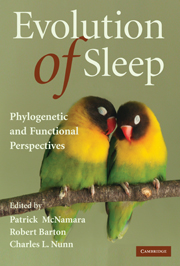Book contents
- Frontmatter
- Contents
- Contributors
- Acknowledgments
- Introduction
- 1 Ecological constraints on mammalian sleep architecture
- 2 Sleep in insects
- 3 Schooling by continuously active fishes: Clues to sleep's ultimate function
- 4 What exactly is it that sleeps? The evolution, regulation, and organization of an emergent network property
- 5 Evolutionary medicine of sleep disorders: Toward a science of sleep duration
- 6 Primate sleep in phylogenetic perspective
- 7 A bird's-eye view of the function of sleep
- 8 The evolution of wakefulness: From reptiles to mammals
- 9 The evolution of REM sleep
- 10 Toward an understanding of the function of sleep: New insights from mouse genetics
- 11 Fishing for sleep
- Index
- Plate section
- References
6 - Primate sleep in phylogenetic perspective
Published online by Cambridge University Press: 10 March 2010
- Frontmatter
- Contents
- Contributors
- Acknowledgments
- Introduction
- 1 Ecological constraints on mammalian sleep architecture
- 2 Sleep in insects
- 3 Schooling by continuously active fishes: Clues to sleep's ultimate function
- 4 What exactly is it that sleeps? The evolution, regulation, and organization of an emergent network property
- 5 Evolutionary medicine of sleep disorders: Toward a science of sleep duration
- 6 Primate sleep in phylogenetic perspective
- 7 A bird's-eye view of the function of sleep
- 8 The evolution of wakefulness: From reptiles to mammals
- 9 The evolution of REM sleep
- 10 Toward an understanding of the function of sleep: New insights from mouse genetics
- 11 Fishing for sleep
- Index
- Plate section
- References
Summary
Introduction
The primates comprise a diverse group of eutherian mammals, with between some 200 and 400 species, depending on the taxonomic authority consulted (e.g., Corbet & Hill, 1991; Wilson & Reeder, 2005). Most of these species dwell in tropical forests, but primates also thrive in many other habitats, including savannas, mountainous forests of China and Japan, and even some urban areas. Living primates are divided into two groups, the strepsirrhines (lemurs and lorises) and the haplorrhines (monkeys, apes, and tarsiers). Strepsirrhines include mostly arboreal species and retain several ancestral characteristics, including greater reliance on smell and (in most species) a dental comb that is used for grooming. Most are nocturnal, but some have, in parallel with most haplorrhines, evolved a diurnal niche. They are found only in the Old World tropics. Haplorrhines are more widely distributed geographically, being found in both the New and Old Worlds. They include two groups, the platyrrhines and the catarrhines. Platyrrhines are monkeys native to the New World. Catarrhines include both Old World monkeys and apes. With the exception of owl monkeys in the genus Aotus, all monkeys and apes are active during the day (i.e., diurnal), and most live in bisexual social groups that vary in size from 2 to well over 100 adults (Smuts, Cheney, Seyfarth, et al., 1987).
Nonhuman primates are among the best-studied of mammals, in large part because of their close phylogenetic relatedness to humans.
- Type
- Chapter
- Information
- Evolution of SleepPhylogenetic and Functional Perspectives, pp. 123 - 144Publisher: Cambridge University PressPrint publication year: 2009
References
- 7
- Cited by



